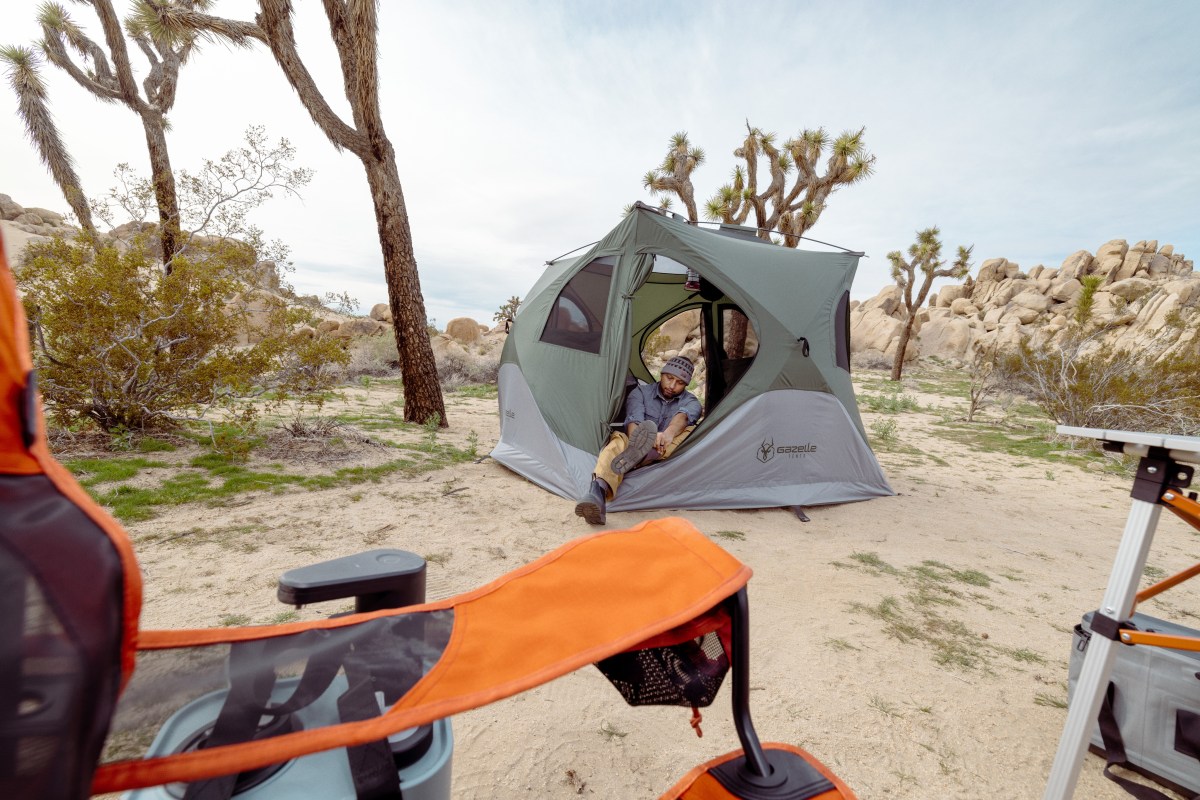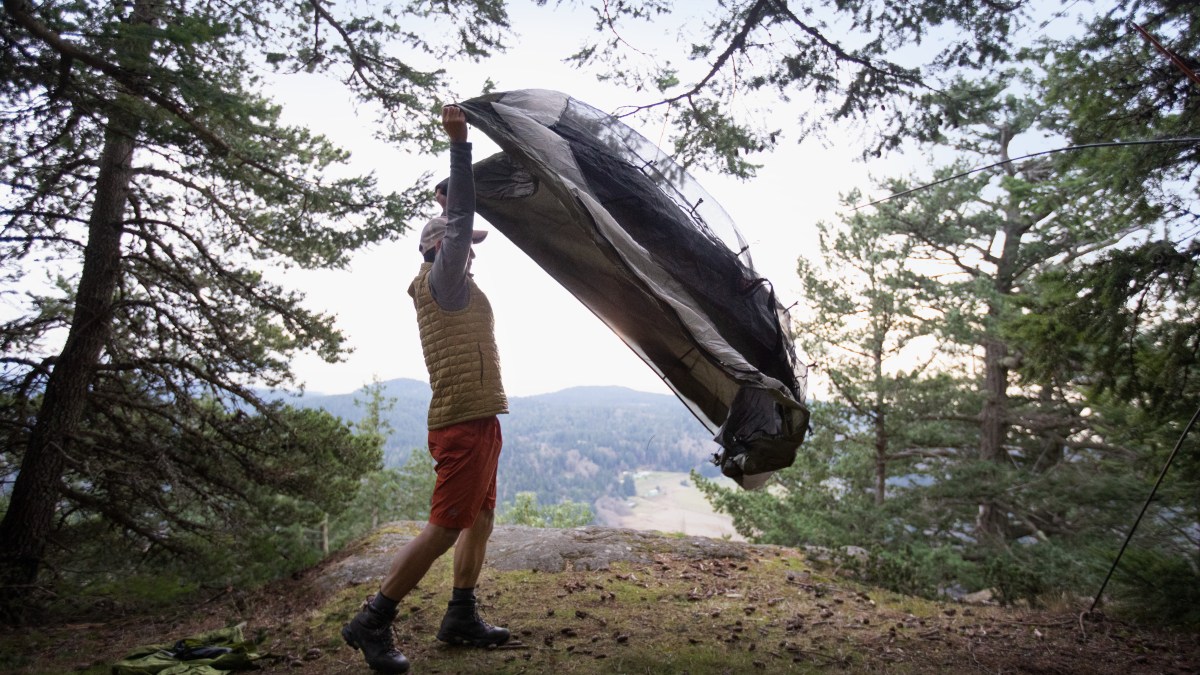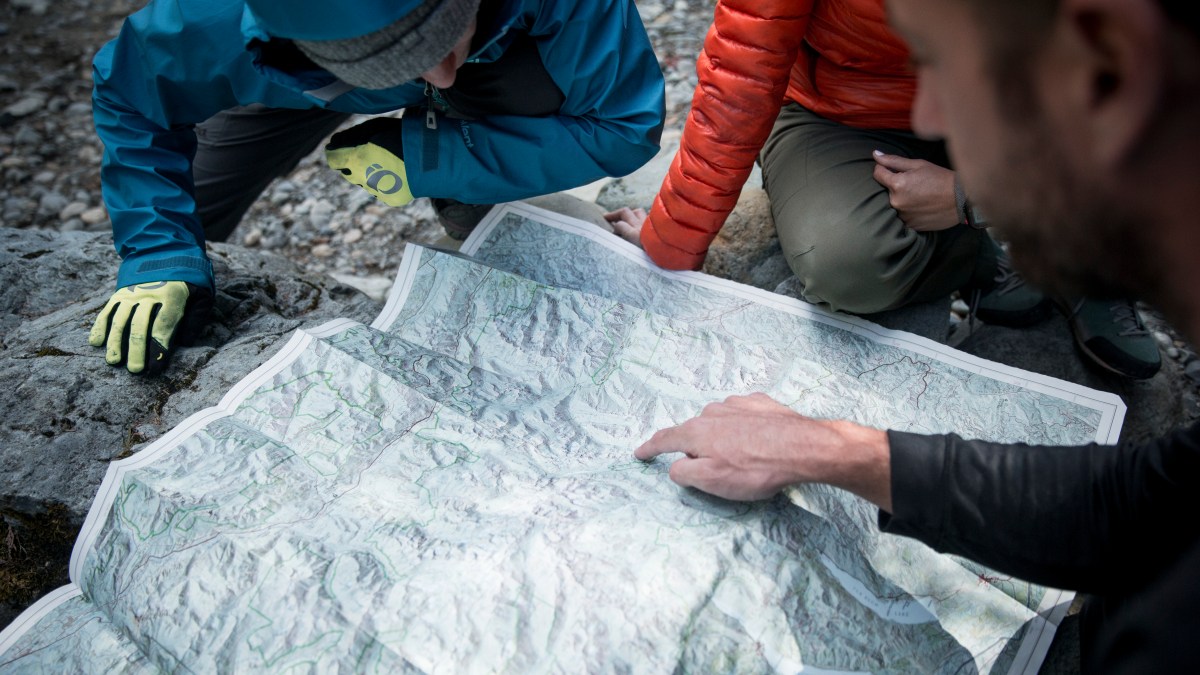There are plenty of reasons to try dispersed camping, or overnighting in a non-designated campground. Maybe you want to test your self-sufficiency outdoors, without cell service and facilities like running water. Perhaps you want to feel closer to nature by camping away from crowds. Whatever your motivation, dispersed camping can be a fun way to expand the places you pitch a tent, and a chance to learn new outdoor skills.
But before you head out for a night unplugged, there are a few things to know, like how dispersed sites differ from designated ones; how to find and select the right site; what gear and skills you’ll need before heading out; and how to be a good steward of the natural places you visit.
In this guide, we tap Jessie Johnson, a Leave No Trace (LNT) master educator, former instructor for LNT’s Traveling Team, and dispersed-camping maven, to better understand all of these things and more. Let’s get into it.
You can also check out our “Where Can I Camp?” guide, which provides a basic overview of where you can pitch a tent, from private campgrounds to tribal lands.
Jump Ahead
- Defining Designated, Dispersed and Designated-Dispersed
- Where to Find Dispersed Campsites
- The Pros and Cons of Dispersed Camping
- How to Find and Select a Dispersed Campsite
- Skills for Dispersed Camping
- What to Bring for Dispersed Camping
Defining Designated, Dispersed and Designated-Dispersed Camping
Before diving in, let’s explore the differences between some of these terms.
Designated Camping and Campsites
If you’ve ever stayed at an established campground, chances are good that it was a designated site. These developed spaces often have some clearly marked campsites; access to amenities like drinkable water, electricity hookups, Wi-Fi or toilets; and a park or forest service typically manages them. Most require a fee to use, and/or an advance reservation. While you’ll frequently find designated spots in front-country areas or car-accessible places, you can also find designated campsites in the backcountry on popular hiking routes like the Appalachian Trail.
Dispersed Camping and Campsites
Dispersed camping typically includes anything outside of a developed, designated campground. It’s not wilderness camping per se, but it is undoubtedly more rustic than a designated area that might have tent platforms or electricity hookups. Unlike designated sites, dispersed spots typically do not have amenities like running water or bathrooms, although well-trafficked areas may have the odd vault toilet (a waterless, non-flushing latrine). This means you’ll need to better prepare for camping in a dispersed area (See: Skills for Dispersed Camping) than you would if you were to set up at a campground.
You can find dispersed sites along U.S. Forest Service roads and in the backcountry (See: How to Find and Select a Dispersed Campsite). These spots are generally free (with the exception of those in parks that have wilderness-use and backcountry-camping permits), and you can’t reserve them ahead of time.
Designated-Dispersed Camping
Typically found in forests and on Bureau of Land Management (BLM) land, these sites are “that funny, in-between land,” of designated and dispersed, says Johnson. That is, they combine elements of both. Designated-dispersed areas typically have established vehicle-accessible sites but lack facilities like lavatories or potable water. Public land managers are starting to create more designated-dispersed areas in popular destinations in an effort to minimize damage to sensitive ecosystems. These established sites encourage campers to use existing spaces instead of creating new ones, which protects vegetation and habitat. You can find these setups in highly trafficked places like the Alabama Hills National Scenic Area (PDF).

Where to Find Dispersed Campsites
Wherever you find federally and state-managed public lands, you’ll likely find dispersed campsites. National forests, BLM lands, state forests and even some wildlife management areas all offer dispersed camping. Most land managers do not allow roadside dispersed camping near developed recreation areas like campgrounds, picnic areas and trailheads. Rules and regulations vary depending on the land manager. Do your research online or by calling the park or forest headquarters before you set out.
The Pros and Cons of Dispersed Camping
Dispersed camping can be an empowering experience and can even be restorative for the mind, body and soul. Yet developing the skills and level of preparedness required for dispersed camping takes time, research and a little trial and error. Here’s what you can expect.
The Pros
There is much to love about dispersed camping. For starters, there’s no better way to unplug. Literally, these areas don’t have electric hookups and are unlikely to have cell reception. Additionally, those who love solitude are more likely to find it at a dispersed campsite, because it takes a little more effort than rolling into an established spot. And because most dispersed sites don’t require reservations, visitors with a flexible itinerary or who prefer impromptu adventures can make plans on the fly. In most cases, it’s free to claim a site—though some state and national parks may require an entrance or vehicle fee or a recreation pass.
You can also choose from different types of dispersed campsites, depending on your comfort and skill level, says Johnson. For folks new to dispersed camping who want to level up their camping skills gradually, for example, selecting a roadside dispersed campsite can feel more approachable than one in the backcountry, because you have access to your vehicle should you need it.
“Dispersed camping offers campers a really good opportunity to dip their toes into something that feels a little wilder and more exciting than campground camping,” says Johnson. “It’s a little off the beaten path, but not too far off the beaten path.”
The Cons
Of course, dispersed camping does come with trade-offs, many of them logistical. Because you need to prepare for more variables than you would when camping at a designated spot—location of water sources, where you intend to go to the bathroom, how you’ll dispose of your garbage—you’ll need to do more upfront planning, which takes time and research, says Johnson. For campers with disabilities, that advanced planning is critical to a successful night outdoors. Although dispersed camping can be less accessible than sites at designated campgrounds, many of which are required by law to be ADA-compliant, it’s not impossible (check out our Guide to Adaptive Camping).
Dispersed camping also requires some specific skills, like reading the terrain to determine the best tent site, purifying water and pooping responsibly (more on this later, in Skills for Dispersed Camping). And you’ll need more gear than you would at a campground, like water treatment devices, a headlamp and a power bank. Dispersed sites usually have no facilities, so you’re on your own when it comes to finding and treating water and locating a spot to relieve yourself, among other things.
Additionally, you shouldn’t anticipate having cell reception and should have a plan in the event of an emergency. In some cases, you may want to invest in a personal locator beacon or satellite communication device (learn about the differences in How to Choose Between a PLB and a Satellite Messenger). These devices connect to satellite networks to allow you to communicate (at varying levels, depending on your device) even when you have little to no cell service. This can be critical in the case of an emergency.
“You almost have to think of it as backpacking,” says Johnson. “You might not be going way out in the woods, but it just requires this extra bit of preparation before you step out the door so you can not only leave no trace but have a better time, feel more comfortable and take care of your own basic needs.”

How to Find and Select a Dispersed Campsite
If you’re willing to put in the extra preparation, a self-sustained night in nature is well worth the effort. Here’s how to make sure you post up camp at a site that works for you and for the environment.
Finding a Site
The first step after deciding to camp is—you guessed it—finding a site. Most national forest or BLM land websites will have dispersed camping maps. If you’re having trouble finding information online, call ahead or visit the ranger district office in person. You can also use certain apps (Gaia GPS, for instance) to find dispersed camping areas.
Typically, people can book dispersed campsites on a first-come, first-served basis, though this varies depending on the land manager. For instance, finding a dispersed site in Idaho’s Sawtooth National Forest may be as simple as looking up authorized dispersed camping areas, driving down a Forest Service road and locating an open space. In Pennsylvania state forests, visitors must reserve primitive “motorized, roadside campsites” (the state’s version of designated-dispersed campsites) and pay a $10 per-night fee. This applies even if the campsite is a short hike from the car. If visitors camp in the backcountry for more than one night, Pennsylvania also requires folks to have a (free) permit, but not all states require one.
Selecting a Site
Now it’s time to find your home away from home. First and foremost, know the Leave No Trace Seven Principles before you head out to any campsite. These best practices help preserve natural spaces, covering everything from minimizing fire impacts to disposing of waste properly. It’s crucial to respect these guidelines when dispersed camping—or camping anywhere.
Whether you want to camp roadside or trailside, try to select an overnight spot that has clearly already been used. That is, search for a spot that looks like someone may have already camped there. You can typically tell by looking for tire tracks from vehicles, established fire rings, and areas cleared for tents. The fewer new campsites people make, the less impact on sensitive vegetation and the wildlife that depends on it. Remember: The best campsite is one you don’t have to create.
“We want to minimize what we call the ‘campsite creep,’ where the campsites just get bigger and bigger and more denuded,” Johnson says. “You’re not looking for a place that’s pristine, that’s your scenery. Look for a surface that is already bare and not a surface that has plants or vegetation on it.”
If you can’t find a site that appears used, consider these Leave No Trace principles when selecting a new spot:
- Look for level ground that has decent drainage.
- Don’t drive anywhere that is not a pre-existing road or pull-off to minimize damage to fragile ecosystems.
- Avoid camping in the middle of a meadow or directly on a trail. This helps keep your campsite less visible, which preserves the “wild” experience other visitors are also seeking.
- Always camp on bare soil and at least 200 feet away from any water source to prevent erosion and contamination. National forests require that dispersed roadside campsites stay within a certain number of feet from a roadway. However, these distances differ from forest to forest. For instance, Utah’s Fishlake National Forest allows camping within 150 feet of a road. The Sawtooth National Forest permits require that sites be up to 300 feet from a road. This is why it’s important to do your homework ahead of time. Our guide on How to Choose a Backcountry Campsite is a great resource.
Assess Your Surroundings
So, you’ve found what looks like a flat, forested site that follows Leave No Trace guidelines. Now look at what’s around you before you set up your tent. Is there adequate canopy cover so your tent fly is not baking in the sun? (Sun exposure can accelerate the breakdown of glue and synthetic fabric.) Are there any dead or dying trees or damaged branches that could break off and fall in the night? (A tree limb crashing on you in your sleep would certainly be a buzzkill.) Can you see fresh signs of scat or recent kills, indicating a nearby cougar den? (Remember that other critters share our lands too.)
Also, account for environmental factors before you leave the land of cell reception. At the very least, check the forecast and wildfire conditions for the duration of your outing. Beyond basic safety concerns, consider how weather can affect your comfort. There’s little worse than having to move in the middle of the night because your low-lying campsite floods when it rains. Or spending a sleepless night on an exposed ridge with high winds battering your tent. And always know the wildfire conditions in the area. InciWeb is a great resource for the latest updates on all active wildfires in the country.

Skills for Dispersed Camping
Whenever you head out into the woods for a night of camping, it’s important to have at least a baseline understanding of how to read a map, whether that’s a paper map or a map-based app like Gaia GPS. Google Maps might help you get to your campsite, but it won’t help you get home if you leave cell range. Write down step-by-step directions both ways just in case. If you use map apps, make sure you download the info to your phone, so you can access it offline.
Always tell someone where you plan to camp and when you expect to be back home, says Johnson. Create a game plan together. Tell your contact to alert local search and rescue teams if they don’t hear from you by a certain point.
In addition to basic orienteering and Leave No Trace knowledge, you’ll also need to know how to use whatever water filter you choose, from gravity filters to ultraviolet light purifiers. Check your water purification device before you head out, given these need replacing after so many uses. If you’re new to filtering water, check out our guide.

What to Bring to a Dispersed Campsite
Generally speaking, you will need everything you normally bring for camping at a designated campground. Although if you’re backpacking in, you may need a heftier pack and want to bring only the essentials). The most important factor you’ll need to account for when dispersed camping is how much water to tote. The general rule of thumb is one and two gallons of water per person per day. If you are camping near a water source like a spring or stream, you can bring less (just make sure to carry a water filter).
If you’re camping in a wildfire-prone area, you may need to bring extra gear, like a 1-gallon bucket of water, a shovel and an ax. Depending on how far your campsite is from a town, make sure your car has a full tank of gas. And consider stocking your vehicle with emergency essentials. These could include a jump-starter power pack for dead car batteries and tire chains if you’re expecting snowy conditions. Whether or not you’re using your phone as navigation, consider bringing a portable charger and its corresponding cables. If you’re heading deeper into the backcountry, invest in a satellite phone or personal locator beacon. They truly save lives. Bring a trash bag so you can easily pack out whatever trash you bring in (and whatever trash you find).
Finally, pack a trowel, toilet paper (look up guidance on whether to pack it out or bury it) and/or an antimicrobial pee cloth, and hand sanitizer. If your dispersed campsite doesn’t have access to a pit toilet, prepare to squat in the woods. You can read our guide on How to Go to the Bathroom in the Woods. Just make sure to confirm whether or not you can dig cat holes where you’re camping. Some land managers only allow the pack-it-out method of disposal. You can call the forest or park headquarters beforehand so you can plan your poo accordingly.
Finally, remember that practice makes perfect. If you forget your headlamp, make a note to remember it next time. (A smart phone flashlight can work in a pinch.) Packing lists for dispersed camping trips vary depending on where and when you’re camping and what you need to feel comfortable. Use this guide as a reference point. Then adjust it to make sure you’re camping in a way that is best for you and for the environment.
And don’t forget—this is about having fun. So take it slow and soak in the experience. The memories you create during a night outside are ones that will last a lifetime. Happy dispersed camping!
Related Links:
Backpacking Checklist
Leave No Trace Seven Principles
How to Choose a Backcountry Campsite
Where Can I Camp?
